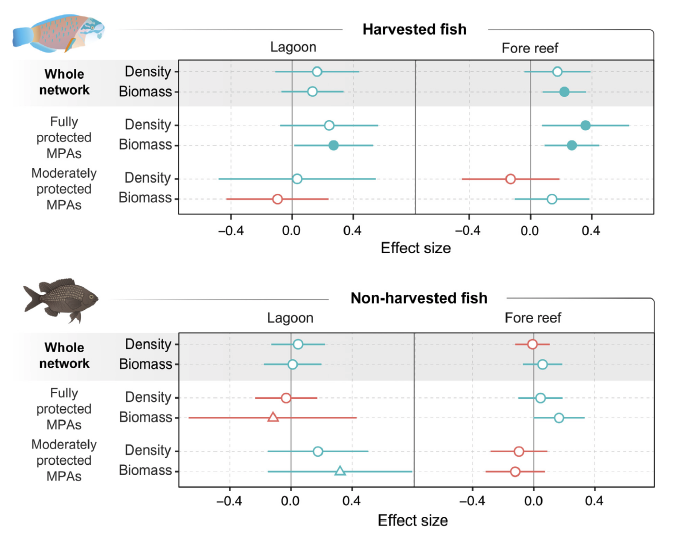 Lauric's paper (pdf) on the response of fishes to the Moorea MPA network is now on-line at Ecosphere. Abstract: Marine protected area (MPA) networks, with varying degrees of protection and use, can be useful tools to achieve both conservation and fisheries management benefits. Assessing whether MPA networks meet their objectives requires data from Before the establishment of the network to better discern natural spatiotemporal variation and preexisting differences from the response to protection. Here, we use a Progressive-Change BACIPS approach to assess the ecological effects of a network of five fully and three moderatelyprotected MPAs on fish communities in two coral reef habitats (lagoon and fore reef) based on a time series of data collected five times (over three years) Before and 12 times (over nine years) After the network’s establishment on the island of Moorea, French Polynesia. At the network scale, on the fore reef, density and biomass of harvested fishes increased by 19.3% and 24.8%, respectively, in protected areas relative to control fished areas. Fully protected areas provided greater ecological benefits than moderately protected areas. In the lagoon, density and biomass of harvested fishes increased, but only the 31% increase in biomass in fully protected MPAs was significant. Non-harvested fishes did not respond to protection in any of the habitats. We propose that these responses to protection were small, relative to other MPA assessments, due to limited compliance and weak surveillance, although other factors such as the occurrence of a crown-of-thorns starfish outbreak and a cyclone after the network was established may also have impeded the ability of the network to provide benefits. Our results highlight the importance of using fully protected MPAs over moderately protected MPAs to achieve conservation objectives, even in complex social–ecological settings, but also stress the need to monitor effects and adapt management based on ongoing assessments.
Lauric's paper (pdf) on the response of fishes to the Moorea MPA network is now on-line at Ecosphere. Abstract: Marine protected area (MPA) networks, with varying degrees of protection and use, can be useful tools to achieve both conservation and fisheries management benefits. Assessing whether MPA networks meet their objectives requires data from Before the establishment of the network to better discern natural spatiotemporal variation and preexisting differences from the response to protection. Here, we use a Progressive-Change BACIPS approach to assess the ecological effects of a network of five fully and three moderatelyprotected MPAs on fish communities in two coral reef habitats (lagoon and fore reef) based on a time series of data collected five times (over three years) Before and 12 times (over nine years) After the network’s establishment on the island of Moorea, French Polynesia. At the network scale, on the fore reef, density and biomass of harvested fishes increased by 19.3% and 24.8%, respectively, in protected areas relative to control fished areas. Fully protected areas provided greater ecological benefits than moderately protected areas. In the lagoon, density and biomass of harvested fishes increased, but only the 31% increase in biomass in fully protected MPAs was significant. Non-harvested fishes did not respond to protection in any of the habitats. We propose that these responses to protection were small, relative to other MPA assessments, due to limited compliance and weak surveillance, although other factors such as the occurrence of a crown-of-thorns starfish outbreak and a cyclone after the network was established may also have impeded the ability of the network to provide benefits. Our results highlight the importance of using fully protected MPAs over moderately protected MPAs to achieve conservation objectives, even in complex social–ecological settings, but also stress the need to monitor effects and adapt management based on ongoing assessments.